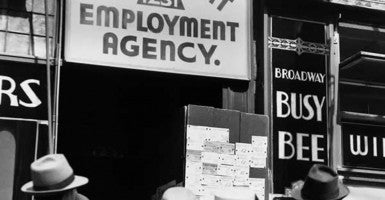In a recent debate on C-SPAN on the condition of the U.S. economy, my liberal sparring partner observed that the bank bailouts and stimulus plans saved us from a second Great Depression.
We’ve all heard that line dozens of times — Barack Obama recites it in nearly every speech he delivers. This claim is what we call a counterfactual — what might have happened if we hadn’t done what we did. The left loves to argue using counterfactuals because — like “climate change” — they are impossible to refute.
No one can say for certain what would have happened in some kind of parallel universe. But getting the story right on this episode of history is a critical issue for American economic policy.
Conservatives must not let the left write the narrative of the financial crisis and the massive and unprecedented government interventions designed to combat it — as they are trying to do.
We let the left write the history books on the Great Depression, and 70 years later it’s an Aesop Fable. Most Americans, my 12-year-old included — are taught that FDR’s New Deal rescued us from the Great Depression and moved millions of Americans out of misery.
Actually, as Amity Shlaes shows in her classic book “The Forgotten Man,” nearly every government regulatory bureau and spending program only lengthened the Depression and disrupted the normal healing powers of a free economy.
Eight years after the New Deal was launched, the unemployment rate was still in double digits, and it was not until the start of World War II — when millions of young men were put in military uniform as the nation mobilized for a global war — did the Depression end. These basic facts somehow get twisted into the enduring fiction that the New Deal worked.
Which brings us to the Great Recession in 2008 and its aftermath.
What is highly inconvenient for the left apologists for the Obama blitzkrieg of government programs and debt in 2009 and 2010 is that at the start of his presidency, he did lay out a counterfactual of what would have happened without the deluge of federal spending and debt.
Here’s the punch line. According to the White House’s own calculations, the economy would have been better off today if the government had done nothing instead of spending and borrowing $6 trillion.
The unemployment rate without the stimulus was expected to be 5% today. Instead it is 6.3% and in reality closer to 10%.
Another way to put this is that if the labor force had not declined and we had the 5% unemployment rate Obama says we would have had without the stimulus, there would be 5 million more Americans working today.
That is the counterfactual that sends Obama loyalists into a rage — because they have a hard time debating against their own number.
Here is another counterfactual to ponder: How much faster would the economy be growing today if we didn’t have the carrying cost of $6 trillion in debt to contend with?
U.S. GDP was supposed to grow at over 2% each year under the do-nothing scenario. In reality, 2% has been the anemic recovery pace.
Why does this matter? Because with even an average recovery we would have $1.3 trillion more GDP today. And under a supply-side, Reagan-style recovery, we would have $2 trillion more of GDP and collective income.
Imagine if we had used all this money to finance a 21st century tax reform or for transitioning Social Security to a fully funded personal account system that has real assets building up each year collecting compound interest, not a vault full of ever-accumulating IOUs.
All of this is important to remember as Obama’s first Treasury secretary pats himself on the back for pulling America out of the financial abyss. He says there were no other options to the bailouts and stimulus plans. Sure there were. Let the normal bankruptcy process run its course instead of stealing money from those who acted prudently to give to the bad actors.
In capitalism, you get rewarded for good decisions and punished for bad ones. Ford didn’t take auto bailout money, and it is doing very well. GM, not so much.
President Obama’s first chief of staff, Rahm Emanuel, let the cat out of the bag in the earliest days of the administration by saying, “A crisis is a terrible thing to waste.” This burst of honesty was an admission that the left exploited the 2008-09 financial crisis as an excuse to do all the things they had wanted to do for years.
Redistribute trillions of dollars to their voters, re-regulate the economy, build massive green energy projects, refinance the Great Society welfare state, rescue the unions with auto bailouts, print money in the trillions. And when the economy fails to perform, blame it all on George W. Bush.
The real story of the financial crisis of 2008 was a massive real estate bubble facilitated by easy money from the Fed, government policies through federal entities like Fannie Mae and Freddie Mac that underwrite risky mortgage loans with near 100% loan guarantees, a Congress and White House that, as Rep. Barney Frank once famously put it, “rolled the dice” on the housing market, and private banks, investors and home owners who got caught up in a speculation frenzy. Then we asked the conspirators like Frank and Sen. Chris Dodd to fix it.
Now we’re repeating the same inane pre-recession mistakes, with government again guaranteeing 90% of new mortgages, financed with easy money and many low down payment loans.
Here we go again. The problem is that when we let the left write the history books, we never seem to learn from our mistakes.
Originally appeared in Investor’s Business Daily






























